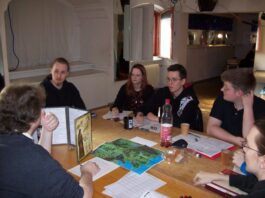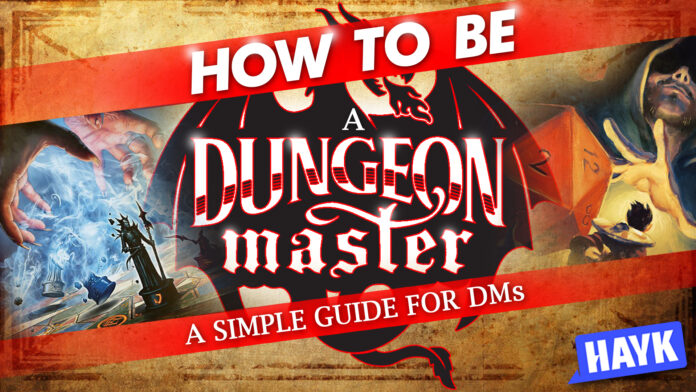
In the world of D&D and tabletop RPGs, Dungeon Masters are the minority. For every DM, there are approximately ten players waiting to join. So, being a DM is like a golden opportunity that everyone must experience.
You can be a DM at your own pace and style. There are no strict rules governing the path of a DM – just tried-and-tested guidelines. Most of these guidelines will even change for the better as you acquire more experience and knowledge.
In this detailed article content, you will learn how to become a professional Dungeon Master. You will also discover the key reasons why DMs run highly detailed sessions and adventures for their players.
A Brief Guide on How to Be A Dungeon Master in Your Own Game
Be a Player First
Every aspiring DM must start as a player or even as a Nerdist just curious about the game. By seeing the adventure through a player’s lens, the DM can come up with interesting situations or combat encounters. If you started D&D as a humble and adventurous player, you’ll have a deep pool of experience that can be useful in building your campaigns.
Take note of the things that you’ve encountered as a player. Were you disappointed by trivial enemies that couldn’t make better tactical decisions? Have you always thought that you can run the encounter in a more interesting way? Understanding these factors is important, especially if you’re already scheduled to take the DM’s chair.
Of course, there’s nothing wrong if you’ve started out as a DM. Such a creative route will keep you busy because there are lots of details to take in. Just bear in mind that the creative process is for your satisfaction, and the session’s outcome is always for your players.
Read Dungeon Master Guides from Several Editions
The D&D 5E Dungeon Master’s Guide is a popular book that launched the creative career of many DMs worldwide. The book has earned dozens of praises, ranging from the artwork to general formatting. Due to the 5E DMG’s popularity, many people believed that it is the only book that DMs can refer to.
Dungeon Master Guides from previous editions are equally valuable, if not better. These books are brimming with lore and tons of complicated yet highly detailed guidelines. From adventuring rules to extraplanar travel, there’s no shortage of information from old DMGs.
One of the barriers of old DMGs is their poor formatting. Almost all of these books have blocky texts that can cause eye strain within minutes. The artwork is also unappealing, though some drawings have a strong nostalgic appeal – as if you’re actually reading an old tome.
Cost is another barrier for most D&D enthusiasts. Unlike the 5E DMG, old Dungeon Master Guides have scaling prices because of their rarity. You might find cheap ones in the market, but they’re probably second-hand or slightly used.
Reading old DMGs is like drinking a glass of expensive wine. It’s all about the experience.
Explore Monster Manuals and Compendiums
Apart from learning how to build your own map or dungeon, Monster Manuals are excellent reading materials. Each Monster Manual contains dozens of monsters with detailed stat blocks and lore information. While you can learn much from D&D 5E Monster Manual, you shouldn’t ignore the manuals from other editions.
The D&D 4E Monster Manual is a great example. The monsters in these books have exclusive roles to fulfill, as well as additional abilities based on their health levels. An injured monster might be near the clutches of death, but it can unleash an ability designed to knock down a player. If you’re feeling creative, you can combine these monster abilities with the current stat blocks of 5E monsters.
Compendiums or sourcebooks are fun to read as well. Some sourcebooks will expand your knowledge about specific realms. Other books will help you utilize the full potential of D&D monsters.
These are some reliable sourcebooks for your growing library:
- Volo’s Guide to Monsters
- Xanathar’s Guide to Everything
- Mordenkainen’s Tome of Foes
- Fizban’s Treasury of Dragons
- The Sword Coast Adventurer’s Guide
Craft a Story Idea
A DM without a story idea is like having a label as a gunslinger without a gun. Your primary role as a DM is to weave a story and guide your players through countless obstacles and encounters. The story serves as a ‘guiding focus’ of your campaign and the north star that players will follow. Well, sometimes, players won’t follow your story and they might choose to do secondary quests instead.
Before you design the campaign’s first encounter, you must prepare a story outline. This outline is the springboard of your campaign, allowing consistent modifications as needed. You don’t need a detailed outline before the first session. Just separate your outline into three phases: beginning, middle, and end. Over time, your outline will grow as players keep on discovering new things about your campaign’s world.
Build a World for Your First Campaign
Worldbuilding is one of the exciting parts of being a DM. In the process of worldbuilding, you can create any world or realm that you want. Have you always wanted to create a world driven by steam and magic? How about a world ruled by royal dinosaur families and chicken warlords? Or perhaps you intend to create a fully adaptable magic system governed by unique concepts. Worldbuilding is the only process that will help you do these things.
Building a world for your campaign is easy but laborious. You don’t need a thick document of information at the beginning. Simply pinpoint the dominant kingdom or state where your players will begin. Write small anecdotes and lore pieces about the world’s most prominent factions. But more importantly, you should focus on the players’ starting location. This location can be a tavern, a dining hall, or even a road that seems to lead into nothing.
Don’t spend too much time on worldbuilding because it might become an excuse not to run a session. Remember, D&D is part-worldbuilding and part-management. You need to find the right level of balance among these processes.
Test the Waters with a One-Shot
If you’re not comfortable running a big campaign right away, try doing a one-shot adventure. Most one-shots can be finished in one session, therefore requiring little bursts of commitment from the players. You don’t even have to create anything from scratch. Just search for PDF one-shots online and pick monsters from the Monster Manual or other sourcebooks.
Running a one-shot adventure is like testing the waters of D&D. It’s better to make small mistakes in a one-shot rather than in a campaign. After a session, most players forget what happened in the one-shot, unless they had extraordinary moments.
One-shots also have unique themes and concepts. You might find holiday-inspired adventures or difficult situations where players are imprisoned within the belly of a large animal. Other one-shots might send the players in a wild goose chase with Easter Eggs from popular D&D titles. The possibilities with one-shots are endless.
Learn How to Use Online Tabletop Tools
The era of digital D&D is definitely here to stay. Even though physical D&D sessions are being held in homes and selected game stores, many people still prefer the safety of their homes. As an aspiring DM in a rapidly changing world, you must adapt to the times by using virtual tabletop tools.
Roll20 is the most accessible tool that you can use today. This program has tons of critical yet essential features like fog, battlemap upload, audio and graphics usage, journal, and a voice chat system. Camera chat is also included, as well as a real-time chat panel and dice roller. Since Roll20 is an all-in-one D&D tool, you should expect for a high learning curve.
The simple alternative to Roll20 is Owlbear Rodeo. Owlbear is a ‘bare-bones’ virtual tabletop tool that allows you to run quick encounters right off the bat. Simply start by opening the tool and uploading a pre-made battlemap. If you don’t have a custom map, you may use the default maps included in the tool. Aside from Owlbear’s map upload, you can use a dice roller, drawing tools, and a limited audio upload (screen share) function.
One more program that you shouldn’t miss is Foundry. This program offers in-depth virtual tabletop control with customizable 3D functions. Foundry has a steep learning curve, but you can always check the documentation or seek help from the tool’s active communities.
Check out this simple video guide on how to use Foundry VTT:
Always Run a Session Zero with Players
Session Zero is an important part of campaign management. This is the session where DMs and players and the community discuss the essential aspects of the campaign such as themes, allowed materials, balance, scheduling, character options, and house rules (if any). Without running a Session Zero, your campaign might fall into unwanted chaos.
To start a Session Zero, you must create a brief summary of your campaign’s notable points. Highlight any themes that might bring discomfort to your players, and give them the chance to opt out of sensitive scenarios. Players are also keen on suggesting character options that they want. Always be reasonable – check your balancing priorities and learn how to say no if an option feels unfair.
If you’re planning to use some house rules, don’t hesitate to get some suggestions from your players. Experienced players can tell you if a house rule is balanced or not, and you can simply make adjustments.
Cool Items That Every Aspiring DM Must Have
Do you want to own some cool items and accessories for your D&D campaigns? You don’t have to look further. In this article section, we’ve reviewed some exciting and helpful D&D accessories to make your game sessions fun and worthwhile.
Arcknight 5E Special Effects
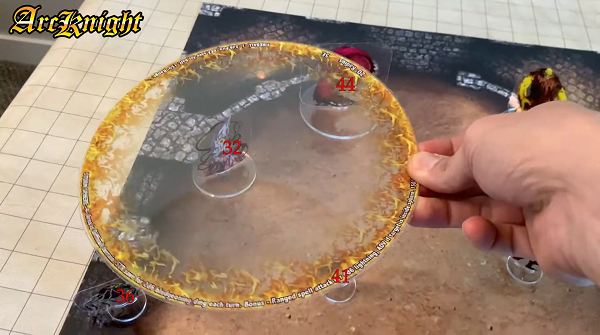
Hand gestures and verbal cues are often used to describe the impact of spells in D&D. Most of the time, the results are accurate. However, players often remember the time when a spell barely touched them yet they received a semi-disastrous effect. This situation can lead to a raging debate between the players and the DM. You should avoid this from happening by using accurate spell markers like the ones from Arcknight.
The Arcknight spell markers can cover all documented D&D 5E spells. These markers are made of pure plastic, and they even have aesthetic designs resembling elemental energies. Aside from markers, the whole Arcknight set contains customizable tokens, a short manual, and reference notes.
Some conditions are not included in the set, but they’re not game-breaking in any way. And even if the Arcknight markers have a storage box, they look unwieldy on the table. Just get a handy clip to compile all plastic markers while you’re not using them.
Conjurer Co Mimic Chest Dice Holder
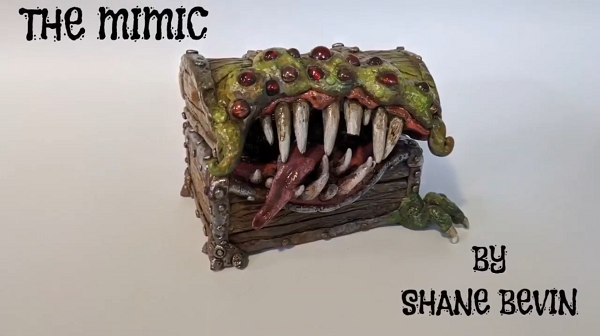
Are you looking for a dice holder that can function as a miniature? Take a look at Conjurer Co’s mimic dice chest. Designed after the iconic D&D monster, the mimic dice holder looks terrifying and ready to devour players. But don’t worry – this dice chest will only devour (or store, rather) dice sets!
Conjurer Co mimic dice chest is heavy and durable. Unlike other dice holders, the mimic chest won’t get damaged once it accidentally falls on the floor. Just don’t let it drop on your foot or you might end up with a throbbing toe. The details of the mimic dice chest are impressive. You’d notice the intricate chest designs, as well as the icky teeth-and-flesh interior. Somehow, the design justifies the mimic holder’s price, though it can still be pricey if your budget is low.
While the mimic dice chest looks awesome, it has some detail inconsistencies. Some areas of the dice chest have chipped paint, and other portions have unequal sizes. These problems are barely noticeable and won’t affect the closing mechanism of the chest.
Forged Dice Co Display Case for Dice
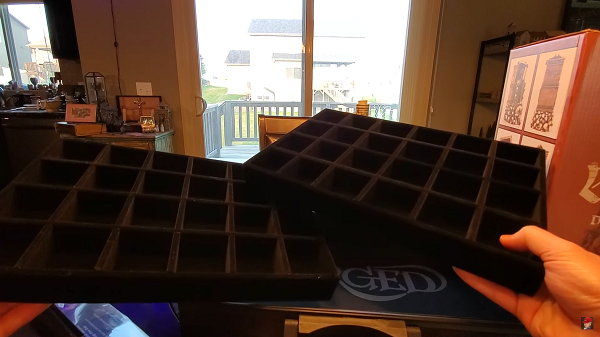
Do you need a new case for your growing collection of dice sets? Forget about those unappealing plastic trays! Instead, turn your attention to Forged Co sturdy dice display case. This versatile case has the capacity for more than a dozen dice sets, and it even has a big handle for easy transfer.
The Forged dice case is more than just a storage box. You can put it on the shelf to show your awesome dice sets. During a game, simply put the case on the table and pull out the dice tray that you need. There are 48 square compartments in the case, and each compartment can hold up to ten dice.
The Forged Dice Co display case has a soft interior lining. Such a lining quality can protect the dice from bumps and scratches. The soft lining, however, might cause minor bump damage to the compartments over time. You can prevent this by securing the display case’s position if you don’t have a game session.
Best Reasons Why You Should Be a DM
For Creative Satisfaction
DMing is like working on a masterpiece. You start by taking a fresh idea and then you flesh it out into workable concepts. Once you’ve prepared the campaign story, you can now show it to your players – session by session.
For many people, DMing is a laborious and almost thankless job. Somehow, they’re half-right. To become a DM, you must shift your perspective to the creative aspect. Don’t think of DMing as a grunt job where you must satisfy the whim of players. As a Dungeon Master, imagine that you are breathing life into a world. You are a herald of Art itself.
DMing is a great outlet for creative expression. If you had a bad day, you can cool off with friends through DMing a fun session. Once your mind enters the creative phase, your memories of the bad day will slowly dissipate. Just make sure that you’re running a session with trusted, reliable friends to avoid many problems or any question on the table.
Building Confidence
Losing confidence is a normal part of life. Many situations can affect your confidence level, and you might even feel depressed for a while. Thankfully, there are numerous ways to rebuild your confidence level. One of them is the intricate process of DMing.
DMs are destined to create and share stories with players. The art of storytelling can boost a DM’s confidence level, especially if players are well-invested in the story. Since DMing requires you to communicate directly with players, any successful session will make you confident. With continuous practice, you might even become a master of the negotiation table.
Strengthening Friendships
D&D is best played with friends and colleagues. In every session, you and your friends will share a few laughs over crazy situations or encounters. There might be snacks, drinks, and relaxing music to make the session as fun as possible. Through your DMing skills, you can create a safe place for your friends. Your session can even help players blow off steam after a week of hard work.
Friendships shared over a D&D table don’t end in the character sheets. If you have a tight-knit group, you might even receive creative inputs from the players, as well as general advice on improving your DMing skills.
During holidays or special occasions, your grateful D&D friends might give you some little gifts like miniatures or even accessories. Try to return the favor by giving gifts to your friends as well.
Measuring Encounters
Even though you can visualize how an encounter will turn out, there are still numerous uncontrolled factors that might appear in a session. These factors are improved player agency, luck, technical loopholes, narrative situations, and surprising tactical advantages. By running a session, you’d learn more about the players, and you can even find new ways to build challenging encounters.
Running a one-shot is like hitting two gryphons with a ballista arrow. Not only will you get the chance to test an encounter, but your players will enjoy the session as well.
Cherishing Remarkable Moments
A group of players burst into uncontrollable laughter as the Paladin rolled a Nat 1 and seduced the enemy instead of killing it. The Barbarian jumped from the hidden ledge and managed to cut off the dragon’s wing in one stroke. After failing twice, the Cleric managed to convince the demigod to join the party’s fight against a Space Lich. These are just some of the extraordinary moments that can happen at any table. For passionate DMs, these creative moments are like small sources of happiness. It’s like watching a pivotal moment in a TV series or enjoying a movie’s cliffhanger.
If you love witnessing or narrating awesome moments, then you should take DMing seriously. The harder you work in your craft, the more moments you’d get to witness. You can also honor these moments by commissioning artwork or writing detailed adventure logs of every session.
Sense of Control
We can’t ignore the pink elephant in the room: DMs love a nearly unparalleled sense of control. This sense of control is only possible by running a session like a well-oiled machine and pulling all reins of narration, combat, and exposition. It’s normal to revel in your omniscient capabilities as a hardworking DM, but you shouldn’t overdo it. You still need to be humble.
If you feel like turning into a control freak, try to assess the situation right away. Are you turning the table against the players? Do you set hopeless traps without at least a small chance of escape? Do you run NPCs with a meta-gaming attitude for the sake of one-upping players? These questions can confirm or deny the fact that you’re being a control freak.
Always remember that the reward of being a DM is witnessing awesome moments. Additionally, getting appreciated by players is also a satisfying reward that can bolster your morale. Don’t let your Ego rob you of such wonderful moments!
A Way to Make Money
Most DMs don’t make money from their creative endeavors. This is not wrong because DMing is a hobby and a work of passion. However, some DMs have already started earning money for their work because they recognized an ever-growing niche.
You can start earning money from DMing by charging a flat fee per session. The price depends on your current setup. Simply justify if your materials or skills deserve the average market rate or perhaps even higher. Check out D&D communities to see the going rates of professional DMs who are already earning money.
Aside from money, being a DM might help you earn additional favors, commission work, barter, and professional referrals. The hobby pays off in the long run.
Treasure Trove: Sources of Creative Inspiration for DMs
All DMs run out of inspiration regularly due to burnouts and difficult life situations. Health problems can also affect a DM’s creativity. If you feel that your ‘creativity well’ is running dry, simply step back from the campaign and explore other works of art. This will let your mind rest and allow you to come back mentally stronger.
World History
World history is filled with interesting events that can serve as inspiration for your campaign. Some events are related to big wars while others are about fiascos and scandals that shook the whole world.
You can start collecting historical events from an online encyclopedia. Pick the events that match your campaign’s theme properly. Don’t copy the historical event directly. Instead, change the important names and add the most important NPCs of your campaign.
The easiest website that you can visit is Wikipedia. This site contains thousands of articles about any given topic. Each article is organized in a detailed manner, revealing important information without fluff. Another website that you should bookmark is History.com. Unlike Wikipedia, History has a relatable appeal and a readable story format. You’d have a blast reading articles from History.
If you can’t access the Internet immediately, just look for magazines or old textbooks in your home. Cut out all the great pieces that you can find and paste them in your handy campaign notebook. These cut-out historical notes will help you build a thriving campaign world later.
Peculiar Daily Events
Keen observation is a great skill that every Dungeon Master should have. Through the power of observation, you’d find remarkable daily scenarios that can fuel your campaign. Perhaps a robbery-gone-wrong can fit its way into your campaign or the story of an imprisoned narco-politician might suffice. Daily events are everywhere – you just need to know where to look.
Walk outside whenever you get the chance. Visit the pub and talk to the locals. Maybe you can gather information or a unique story with multiple perspectives. Your friends can even share stories or rumors that they’ve found. All you have to do is observe and listen.
Big Battles in Literature
Big battles will always be a part of literature. Many books were written about wars through the eyes of suffering characters. Some of these classic titles are War and Peace, All Quiet on the Western Front, Lord of the Rings, Narnia, and Dune. Big battles drive the plot, and they can help you create multi-connected stories meant for players. Plus, most players love to engage in big battles with tactical advantages.
Setting up a big battle requires long planning. You have to move the strings through your selected NPCs. If possible, you should drop plot herrings to be followed by players. Even if the players don’t follow the herrings, they will always get back to the main story after a few sessions. It’s okay to ‘railroad’ players as long as you do it subtly without heavy consequences.
Non-D&D Systems
Are you curious about the mechanics of other tabletop RPGs? While D&D covered huge aspects of adventuring, it’s still not perfect. There’s no perfect system after all. D&D’s imperfection is actually a great thing because it allows you to explore other exciting systems. These systems can rev up your mind and help you become more creative than ever.
One new system that you shouldn’t miss is Pathfinder 2nd Edition. Taking its roots from the first Pathfinder, Pathfinder 2E is all about streamlined adventuring. In Pathfinder 2E, players can enjoy deep adventuring rules, tactical combat, convenient progression rules, and satisfying still checks. The system is still as crunchy as Pathfinder 1E, but it’s not convoluted. You can even use old sourcebooks from Pathfinder 1E with only some minor tweaks.
Dungeon World is another system that will spur your creativity. This system is similar to D&D except in the manner of resolving checks. Since the checks are simple, the plot will move forward easily without narrative problems. The downside of Dungeon World is the tremendous effort needed to come up with unique results for every skill check.
Lastly, you must try the popular Fate system. Under this mechanical system, players can change the outcome of their rolls through fate points. These points are usually awarded during progression, story milestones, and custom plot-based scenarios. If you want to see your players succeed, Fate is the answer.
Stripping a system and adding it to your campaign is normal. But before you combine D&D and other systems, don’t forget to assess the game’s balance. Test everything out with simple dice simulations to see if the new ‘hacked’ system is balanced or not.
Online Adventure Logs
From small blogs to big sponsored forums, online RPG logs are everywhere. These logs are usually blog posts written in a chapter-based progression. Some adventure logs are similar to modern reports, cutting the exposition in favor of raw details. Reading adventure logs is a great way to exercise your mental capacity while you’re not running a session.
Creating an adventure log is easy. You can host the logs on your website or in an active tabletop RPG forum. If your campaign logs are public, other people will get the chance to offer constructive insights. They might even learn a thing or two from your campaign!
FAQ for Dungeon Masters
Is it hard to become a Dungeon Master?
Answer: For some people, being a DM is easy while others usually have a hard time. The answer depends on your dedication and level of creativity. DMing is a long learning process, and you will encounter many errors throughout the journey. The life of a DM is as hard or as easy as it can be!
Is it possible to get paid in DMing?
Answer: Yes, it’s possible to make money in DMing. Some DMs already make a living out of their D&D sessions, but the path is not easy. You need to master the art of improvisation, and the quality of your campaign should reflect the admission cost.
What are the best attitudes of a reliable DM?
Answer: The best attitudes that a DM must have are adaptability, empathy, professionalism, sportsmanship, resourcefulness, and camaraderie. It takes consistent practice to become better with these attitudes, and there are always new lessons to learn.
What tools should I have as a DM?
Answer: Every DM must have a handy notebook, a DM screen, a stack of clean index cards, and some token markers. A smartphone or a laptop can also help in running encounters and taking note of many things during a session.
What D&D books should I read to become a great DM?
Answer: There’s no mandatory list of books for anyone who wants to DM. Most fantasy books are great for improving vocabulary and experience, and official D&D rulebooks are meant for additional learning. Still, as a new DM, you can never go wrong by reading the 5E Player’s Handbook or the Dungeon Master’s Guide
Conclusion
Once you’ve followed the initial steps highlighted in this article, you’d have the chance to become a successful professional DM. Learning the steps is actually the beginning of your journey. There will be many hurdles along the way, so you must always find the reasons why you’ve taken the path of a Dungeon Master. If all else fails, remember your love and passion for the fantastic worlds of D&D!
Have you started running a D&D campaign or one-shot? Tell us in the comments, and we might check out your game!


